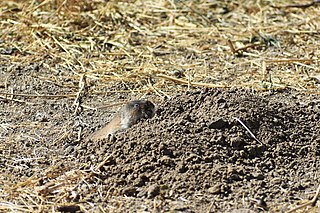
Voles are small rodents that are relatives of lemmings and hamsters, but with a stouter body; a longer, hairy tail; a slightly rounder head; smaller eyes and ears; and differently formed molars. They are sometimes known as meadow mice or field mice.

The Arvicolinae are a subfamily of rodents that includes the voles, lemmings, and muskrats. They are most closely related to the other subfamilies in the Cricetidae. Some authorities place the subfamily Arvicolinae in the family Muridae along with all other members of the superfamily Muroidea. Some refer to the subfamily as the Microtinae or rank the taxon as a full family, the Arvicolidae.

The Balkan snow vole, also known as Martino's snow vole, is the only living member of the genus Dinaromys. The genus name means "Dinaric mouse", referring to the Dinaric Alps, as the species is endemic to the western Balkans of southeast Europe. Eight subspecies of this vole have been recognized, although in 2022 this number was reduced to two subspecies. The Balkan snow vole is a living fossil, the only living species in the tribe Pliomyini, and might arguably better be placed in Pliomys, a genus established for its fossil relatives even before the Balkan snow vole was scientifically described. It was described by husband and wife mammalogists Vladimir Emmanuilovich Martino and Evgeniya Veniaminovna Martino. Others have argued that Pliomys should be treated as entirely separate from Dinaromys, with Dinaromys and P. lenki estimated to have genetically diverged around 4 million years ago based on ancient DNA sequences. The earliest representatives of Dinaromys like Dinaromys allegranzii date to the Early Pleistocene, with Dinaromys also inhabiting the Italian Peninsula until the end of the Late Pleistocene, when it contracted to its current distribution.
The Alai mole vole is a species of rodent in the family Cricetidae. It is known only from Kyrgyzstan, where it has been found in temperate grassland in the Alai Mountains. Little else is known about the vole.

Ellobius is a genus of rodents in the family Cricetidae. It contains two of the handful of examples of mammal species that have lost the Y chromosome.
The southern mole vole is a species of rodent in the family Cricetidae. It is found in Afghanistan, Iran, Pakistan, and Turkmenistan.

The Transcaucasian mole vole is a species of rodent in the family Cricetidae.

The northern mole vole is a species of rodent in the family Cricetidae. It is distributed over large parts of Eastern Europe and Asia.

The Zaisan mole vole, or eastern mole vole, is a species of rodent in the family Cricetidae. It is found in central Asia.

Eothenomys is a genus of rodent in the family Cricetidae. It contains the following species:

Ellobiusini is a tribe of voles containing two genera: Ellobius and Bramus. All extant taxa in this tribe were formerly included in the genus Ellobius. These species are distinguishable from most other voles in that they are highly fossorial, resembling the blesmols and spalacids more than other voles. The long-clawed mole vole is unrelated to these species. The nomenclature of this tribe is unresolved but may be changed to Bramina. "Ellobiusini" may be preoccupied by a tribe of snails in the family Ellobiidae.















